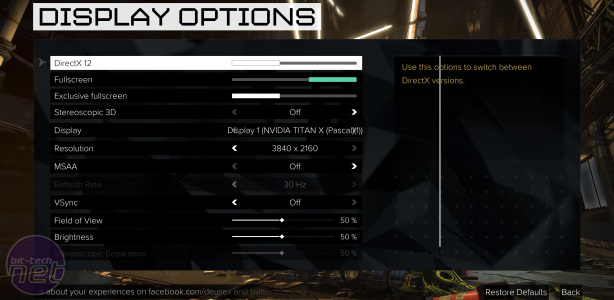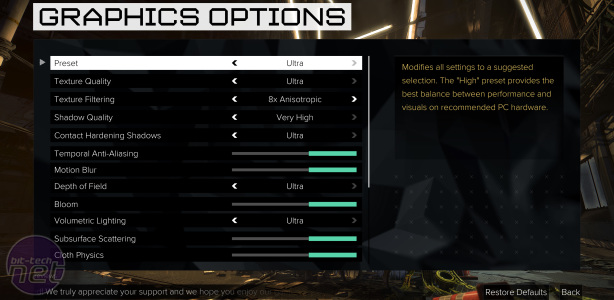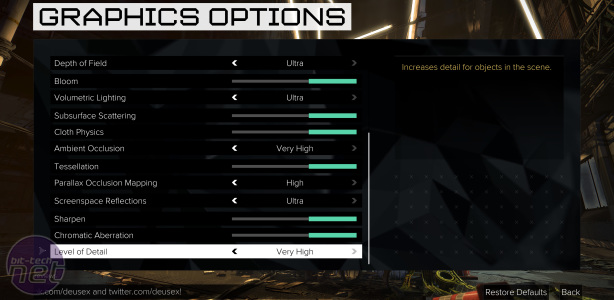Deus Ex: Mankind Divided Benchmarked: What Do You Need To Run It?
August 23, 2016 | 13:43
Companies: #eidos-montreal

Test Setup
To test Deus Ex: Mankind Divided, we used our standard GPU test rig. It's based on the mighty Intel X99 platform with a Core i7-5960X overclocked to 4.2GHz so we won't be bottlenecked by a lack of CPU cores or clock speed.Test System
- CPU: Intel Core i7-5960X at 4.2GHz (33 x 127.3MHz)
- Motherboard: Asus Rampage V Extreme
- Memory: 4 x 4GB Corsair Vengeance LPX 2,800MHz DDR4 (at 2,667MHz)
- PSU: Corsair AX1500i
- SSD: OCZ Vector 180 960GB
- Case: Corsair Graphite Series 760T
- CPU cooler: Corsair Hydro Series H75
- Operating system: Windows 10 64-bit
Deus Ex: Mankind Divided has a built-in benchmark hidden in the Extras menu. It's about 90 seconds long but we benchmark only the first 30 seconds of it as this contains the most stressful part and we found it to be representative of the whole. We repeat each run until a consistent result is obtained – usually twice since it's such a reliable benchmark. We record the results using FRAPS, and report the average and minimum frame rates. We found that your experience in-game will typically be with frame rates actually a little higher than the average frame rate from the benchmark, but even so it's the minimum frame rate that we focus on and that you should really take into consideration because it's in the most challenging parts of the game that you'll really feel the slowdowns, and it's no good having a sub-par experience in the heat of battle.
All cards have been tested at 1080p, and the vast majority have also been put through their paces at 1440p. For the 4K testing, we've used only cards towards the top-end of the product stacks, since only these are remotely capable of handling so many pixels. For each resolution, we have results for each of the game's presets as detailed on the previous page, although we've excluded 'Low' settings, firstly in the interest of time but also since at that point it's probably better to play on a lower resolution or upgrade your GPU. The testing is also strictly GPU-focussed - the impact of a different CPU or memory kit is outside the scope of this article.
Lastly, while we've used reference cards where possible, these aren't supplied as often as they used to be, so in most instances we're using third party partner cards, usually with factory overclocks applied. As such, the results should not be taken as set in stone. Without further ado, here is the full list of tested cards.
AMD Graphics Cards
- Sapphire Radeon RX 480 Nitro 8GB - 1,342MHz GPU, 8GHz GDDR5 (Radeon Software Crimson 16.8.2)
- Sapphire Radeon RX 480 Nitro 4GB - 1,306MHz GPU, 7GHz GDDR5 (Radeon Software Crimson 16.8.2)
- XFX Radeon RX 470 RS 4GB - 1,256MHz GPU, 7GHz GDDR5 (Radeon Software Crimson 16.8.2)
- Gigabyte Radeon RX 460 WindForce 2X OC 2GB - 1,212MHz GPU, 7GHz GDDR5 (Radeon Software Crimson 16.8.2)
- AMD Radeon R9 Fury X 4GB - 1,050MHz GPU, 1GHz HBM (Radeon Software Crimson 16.8.2)
- Sapphire Radeon R9 Fury Nitro 4GB - 1,050MHz GPU, 1GHz HBM (Radeon Software Crimson 16.8.2)
- Sapphire Radeon R9 390X Nitro 8GB - 1,080MHz GPU, 6GHz GDDR5 (Radeon Software Crimson 16.8.2)
- Sapphire Radeon R9 390 Nitro 8GB - 1,040MHz GPU, 6GHz GDDR5 (Radeon Software Crimson 16.8.2)
- Sapphire Radeon R9 380X Nitro 8GB - 1,040MHz GPU, 6GHz GDDR5 (Radeon Software Crimson 16.8.2)
- Sapphire Radeon R9 380 ITX Compact 4GB - 1,000MHz GPU, 5.8GHz GDDR5 (Radeon Software Crimson 16.8.2)
- Asus Radeon R9 280X DirectCU II 3GB - 1,000MHz GPU, 6GHz GDDR5 (Radeon Software Crimson 16.8.2)
Nvidia Graphics Cards
- Nvidia GeForce Titan X (Pascal) 12GB - 1,417MHz GPU (1,531MHz boost), 10GHz GDDR5X (GeForce 372.54)
- Inno3D GeForce GTX 1080 iChill X3 8GB - 1,759MHz GPU (1,898MHz boost), 10.4GHz GDDR5X (GeForce 372.54)
- MSI GeForce GTX 1070 Gaming X 8GB - 1,607MHz GPU (1,797MHz boost), 8.1GHz GDDR5 (GeForce 372.54)
- Nvidia GeForce GTX 1060 Founders Edition 6GB - 1,506MHz GPU (1,708MHz boost), 8GHz GDDR5 (GeForce 372.54)
- Nvidia GeForce GTX 980 Ti 6GB - 1,000MHz GPU (1,075MHz boost), 7GHz GDDR5 (GeForce 372.54)
- Nvidia GeForce GTX 980 4GB - 1,126MHz GPU (1,216MHz boost), 7GHz GDDR5 (GeForce 372.54)
- Asus GeForce GTX 970 DirectCU Mini 4GB - 1,088MHz GPU (1,228MHz boost), 7GHz GDDR5 (GeForce 372.54)
- Palit GeForce GTX 960 Super JetStream 2GB - 1,279MHz (1,342MHz boost), 7.2GHz GDDR5 (GeForce 372.54)
- Gigabyte GeForce GTX 950 OC 2GB - 1,089MHz (1,266MHz boost), 6.6GHz GDDR5 (GeForce 372.54)
- MSI GeForce GTX 670 OC 2GB - 965MHz GPU (1,045MHz boost), 6GHz GDDR5 (GeForce 372.54)
- Gigabyte GeForce GTX 660 OC 2GB - 1,033MHz GPU (1,098MHz boost), 6GHz GDDR5 (GeForce 372.54)

MSI MPG Velox 100R Chassis Review
October 14 2021 | 15:04











Want to comment? Please log in.